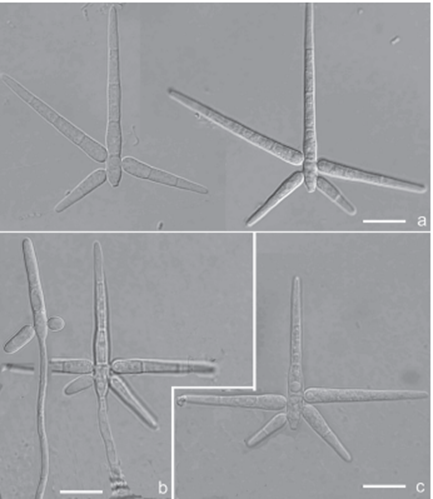 91
91
Triscelophorus anisopteriodeus Z. F. Yu, M. Qiao & R. F. Castañeda, sp. nov. 2021
Fungorum number: IF556148
Facesoffungi Number No: FoF05747
Holotype YMF 1.04267
Morphological description :
Asexual morph: hyphomycetous. Colonies on CMA, attaining about 1 cm diam. after 20 days at 25 °C, light smoky grey. Reverse smoky grey. Mycelium superficial and immersed, composed of branched, septate, hyaline hyphae. Conidiophores macronematous, mononematous, cylindrical, erect, flexuous, unbranched, smooth, hyaline, up to 20–110 µm long. Conidiogenous cells monoblastic, cylindrical, terminal, integrated, determinate, smooth, hyaline. Conidia solitary, acrogenous, staurospore, septate, composed of a main axis and 2–4 lateral branches: i) the main axis elongate obclavate, 2–4-septate, straight, smooth, hyaline, 31.2–48 × 3–5.2 µm; ii) 2–4-lateral branches obclavate to broad obclavate, straight, smooth, hyaline, all arising divergent, unequal, from the basal cell of the main axis: ii a) upper two lateral branches, 2–3-septate, 8.2–38.7 × 2.5–4.8 µm, more or less opposite, arranged just below the supra-basal septum; ii b) lower lateral branches, 0–1-septate, 14–20 × 5–5.5 µm, sequential opposite arranged near the middle of the basal cell.
Sexual state: unknown
Culture characteristics:
Habitat: on submerged leaves,
Distribution: China, Hainan Province, Limu Mountain Nature Reserve,
GenBank: lsu MK577818; its MK569511.
Notes: Triscelophorus anisopteriodeus is differentiated from other known Triscelo2like a dragonfly-shape (Seifert et al. 2011). Four lateral branches are not arising from the same level at the basal cell of main axis. Two shorter ones are lower and two longer ones are upper. Amongst conidia of Triscelophorus spp., three lateral branches are often growing in a whorl, while 2 lateral branches are in pairs. Four lateral branches in pairs in T. anisopteriodeus make it easily recognisable. Morphologically, T. anisopteriodeus is similar to Triramulispora duobinibrachiata K. Ando in conidial shape, but T. anisopteriodeus has larger size of conidia (main axis: 31.2–48 × 3–5.2 vs. 19–36 × 2.5–3.5 µm) and more septa in branches (Ando 1993).
Reference:[1] Qiao, M. , Zheng, H. , Guo, J. S. , Castaeda-Ruiz, R. F. , Xu, J. P. , & Peng, J. , et al. (2021). Two new asexual genera and six new asexual species in the family microthyriaceae (dothideomycetes, ascomycota) from china. MycoKeys, 85, 1-30.
Triscelophorus anisopteriodeus (Holotype YMF 1.04267) a, c conidia b conidiophores with conidia. Scale bars: 10 µm (a–c).

